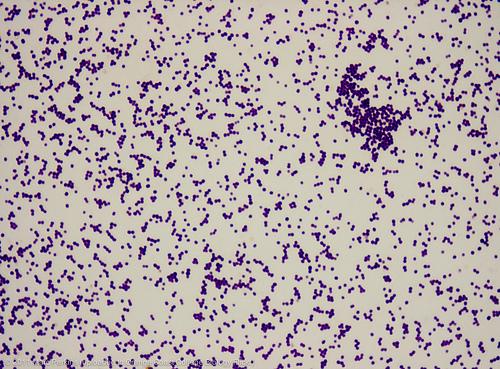Who introduced into microbiology the procedure of air drying, chemical fixation and aniline dyes?
Robert Koch
Staining bacteria enhances the _______ between and the surrounding environment and permits observation of greater detail and resolution than wet mounts do.
bacteria
How are microorganisms prepared for staining?
smearing them onto a microscope slide
Name the various tools you can use to transfer bacteria to a microscope slide.
inoculating loop and a needle
With simple techniques may involve _______________ in which only _______ ________ is used and all the bacteria are similarly stained.
simple stains
one reagent
Multiple reagents being used is called______________ and the bacteria react to the reagents the same or different?
differential stains
different (differential stains)
Why are structural stains used?
to identify specific parts of microorganisms
Most bacteria that are grown in the laboratory are _________ and ___________________.
cocci
rods
Gram-positive cocci.
Staphylococcus aureus
Gram-negative bacilli
Escherichia-coli
Define a smear
a thin film of bacterial cells put on a slide
A smear is prepared by:
bacterial broth- using an inoculating loop take a small of amount of the liquid and smear it on to the slide and let completely air dry
solid-remove a small amount of bacterial culture mix with a drop of water on the slide and allow to air dry.
The ______ must be fixed to __________ the bacteria.
smear
fix
Coagulated ________ from the cells will cause cells to stick to the slide
proteins
Fixing denatures bacterial enzymes preventing them from digesting cell parts which cause the cells to break is a process called _____________?
autolysis
Fixing also preserves _________ with minimal shrinkage or distortion when stained.
microbes
The dry smear is passed through a ____________ several times to __________ the bacteria.
Bunsen burner
heat fix
To chemically-fix the bacteria cover the smear with 95% _____________ for 1 minute.
methanol
Most stains used in microbiology are?
synthetic aniline dyes from benzene
The dyes are usually _______ but some are _____ or ________.
salts
acids or bases composed of charged colored ions
The ion that is colored is referred to as a _____________.
chromophore
Methylene blue chloride
Methylene blue+ + Cl-
(Chromophore)
If the chromophore is a positive ion like the previous Methylene blue equation (Methylene blue+)the stain is considered a ______________.
basic stain
if it is a negative ion it is an ______________.
acidic stain
True or false. Most bacteria are stained when a basic stain permeates the cell wall and adheres by weak ionic bonds to the bacterial cell, which is slightly negatively charged.
true
Preparing smears:
-start with a clean slide
-handle slides by the edge
mark bottom of the slide with a circle to mark where bacteria goes
-sterilize your inoculating loop heating to redness
allow the loop to cool without touching it or setting it down about 30 seconds
-from solid media- put a drop of water in the circle
-from liquid media-place 2 or 3 loopfuls of the liquid culture on the slide with the sterile loop
-allow the smears to dry at room temp
What species is a rod?
bacillus

This is?
Staphylococcus epidermidis

This is?
Bacillus megaterium
Which bacteria is a rod?
Bacillus megaterium
Which bacterium is larger?
Bacillus megaterium
What value is a simple stain?
a simple stain enhances the contrast between the bacterium and its surrounding material and permits greater clarity of detail.
What is the purpose of heating fixing the smear?
kill the bacteria and preserves them with minimal shrinkage and damage to the microbe.
Another method of fixing smear is _____________?
chemically fixing
How does alcohol chemically fix the bacteria?
•It removes water, it dehydrates the cells. This is important when mounting the cells in non-aqueous mounting medium.
•It denatures proteins. This way the metabolism of the cell is stopped and the cell dies. The metabolism is dependent on enzymes, which are proteins.
•It dissolves and removes lipids. The cell membrane(s) of the bacteria is harmed by the alcohol.
In heat fixing what would happen if too much heat was applied?
heat will distort the cells shape and cause splattering in the air.
Methylene blue can be prepared as a basic stain or an acidic stain. How much would the pH of the stain affect the staining of bacteria?
The pH will determine if the bacteria will have a particular charge
Of what value is a simple stain?
Simple stains can be used to determine cell morphology size and arrangement
Can dyes other than methylene blue be used for direct staining?
yes, crystal violet, basic fuchsin and safranin are all dyes that can be used in direct staining because they are cationic with a positive charge
Bacteria can be seen without staining. Why is Koch's recommendation for fixing and staining important for microbiology?
fixing and staining allows the bacteria to be saved and re-examined and shared for study
Negative Stain
simple stain that stains the background but leaves the bacteria unstained
Why is the gram stain a very useful stain?
Identifying and classifying bacteria. Differential stain that allows you to classify bacteria as either gram-positive or gram-negative
Who discovered the gram staining technique?
Hans Christian Gram
Infection quality control staff in a sterilization unit of a hospital used a simple stain to determine whether bacteria was present in sterilized materials. A simple stain of sterile saline used for respiratory therapy revealed the presence of bacteria. Is the saline contaminated?
yes it is because the water should be free of bacteria